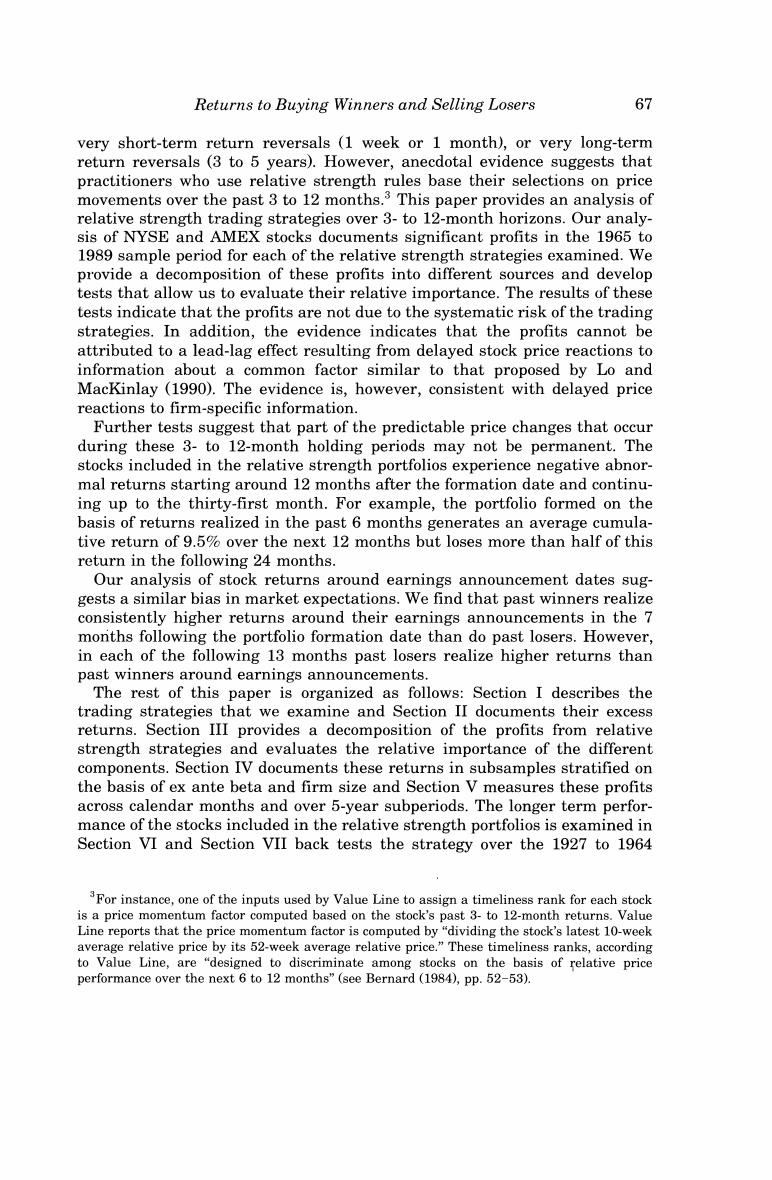正在加载图片...

Returns to Buying Winners and Selling Losers 67 very short-term return reversals (1 week or 1 month),or very long-term return reversals(3 to 5 years).However,anecdotal evidence suggests that practitioners who use relative strength rules base their selections on price movements over the past 3 to 12 months.3 This paper provides an analysis of relative strength trading strategies over 3-to 12-month horizons.Our analy- sis of NYSE and AMEX stocks documents significant profits in the 1965 to 1989 sample period for each of the relative strength strategies examined.We provide a decomposition of these profits into different sources and develop tests that allow us to evaluate their relative importance.The results of these tests indicate that the profits are not due to the systematic risk of the trading strategies.In addition,the evidence indicates that the profits cannot be attributed to a lead-lag effect resulting from delayed stock price reactions to information about a common factor similar to that proposed by Lo and MacKinlay (1990).The evidence is,however,consistent with delayed price reactions to firm-specific information. Further tests suggest that part of the predictable price changes that occur during these 3-to 12-month holding periods may not be permanent.The stocks included in the relative strength portfolios experience negative abnor- mal returns starting around 12 months after the formation date and continu- ing up to the thirty-first month.For example,the portfolio formed on the basis of returns realized in the past 6 months generates an average cumula- tive return of 9.5%over the next 12 months but loses more than half of this return in the following 24 months. Our analysis of stock returns around earnings announcement dates sug- gests a similar bias in market expectations.We find that past winners realize consistently higher returns around their earnings announcements in the 7 months following the portfolio formation date than do past losers.However, in each of the following 13 months past losers realize higher returns than past winners around earnings announcements. The rest of this paper is organized as follows:Section I describes the trading strategies that we examine and Section II documents their excess returns.Section III provides a decomposition of the profits from relative strength strategies and evaluates the relative importance of the different components.Section IV documents these returns in subsamples stratified on the basis of ex ante beta and firm size and Section V measures these profits across calendar months and over 5-year subperiods.The longer term perfor- mance of the stocks included in the relative strength portfolios is examined in Section VI and Section VII back tests the strategy over the 1927 to 1964 3For instance,one of the inputs used by Value Line to assign a timeliness rank for each stock is a price momentum factor computed based on the stock's past 3-to 12-month returns.Value Line reports that the price momentum factor is computed by"dividing the stock's latest 10-week average relative price by its 52-week average relative price."These timeliness ranks,according to Value Line,are "designed to discriminate among stocks on the basis of relative price performance over the next 6 to 12 months"(see Bernard (1984),pp.52-53)